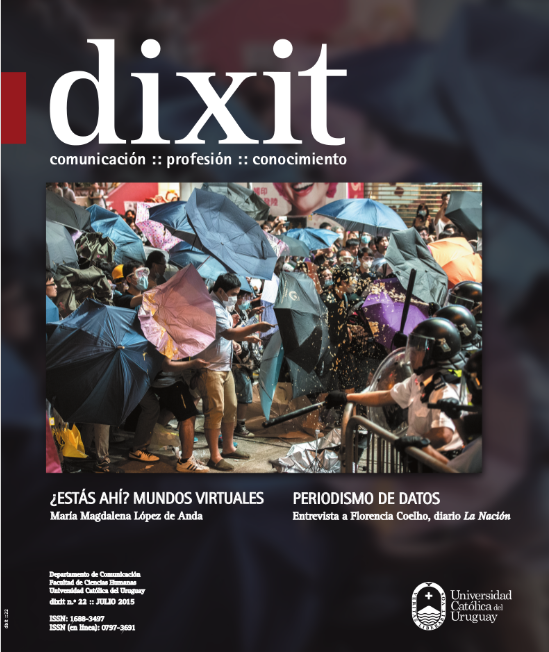Are you there? Representation and co-presence in virtual worlds
DOI:
https://doi.org/10.22235/d.v0i22.378Keywords:
Computer Mediated Communication CMC, Virtual Worlds, representation, co-presence, Second LifeAbstract
Social interaction in virtual worlds is experienced through practices that require digital representation forms of those who participate in them. Through an ethnographic observation in the virtual environment Second Life, we would contribute to the understanding of some relationships between the resources through the users are shown to others and encourage a sense of co-presence. We identify and characterize seven categories of relationship between co-presence and representation. These categories show us technical conditions proper to the environment, and interaction strategies of the participants in two axes: temporary resources management (participation rates) and spatial occupied (co-presence diversified). Finally, the strategies of on line co-presence enlarge the human ubiquity sense. These are core skills for the new reticular and multi scenic social forms.Downloads
References
Andersen, P. B., y Nowak, P. (2002). Tangible Objects: Connecting Informational and Physical Space (pp. 190-214). L. Qvortrup (Ed.), Virtual Space: Spatiality in Virtual Inhabited 3D Worlds. Londres: Springer.
Benedikt, M. (2008). Cityspace, Cyberspace, and the Spatiology of Information. Journal of Virtual Worlds Research, 1(1), 1-22.
Benedikt, M. (Ed.) (1991). Cyberspace. Cambridge (EUA): MIT Press.
Bodumn, L., y Kjems, E. (2002). Mapping Virtual Worlds. L. Qvortrup (Ed.), Virtual Space: Spatiality in Virtual Inhabited 3D Worlds (pp. 75-92). Londres: Springer.
Boellstorff, T. (2008). Coming of Age in Second Life: An Anthropologist Explores the Virtually Human. Princeton: Princeton University Press.
Castells, M., Ardévol, M., Linchuan, J., y Araba, S. (2007). Future assemblies: theorizing mobilities and users. New Media and Society, 9(6), 1029-1036.
Castronova, E. (2003). Theory of the avatar. CESIFO Working Papers. Recuperado de: http://www.cesifogroup.de/pls/guestci/download/CESifo%20Working%20Papers%202003/CESifo%20Working%20Papers%20February%202003%20/cesifo_wp863.pdf
Castronova, E. (2005). Synthetic Worlds: The Business and Culture of Online Games. Chicago: University of Chicago Press.
Cortazar, F. J. (1998). Ciberrelaciones: amistad, amor y sexo en los salones de chat. Comunicación y Sociedad, 34, 129-155.
Crary, J. (1990). Techniques of the Observer: On Vision and Modernity in the Nineteenth Century. Cambrigde (EUA): MIT Press.
Czarnecki, K. (2008). Building Community as a Library in a 3D Environment. Australasian Public Libraries and Information Services (APLIS), 21(1), 25-27. Recuperado de: http://web.ebscohost.com/ehost/pdf?vid=8&hid=12&sid=b793179d-6ec2-4a27-a28c-9726195f6c9e40sessionmgr2
Eco, U. (1978). La estructura ausente: introducción a la semiótica. Barcelona: Lumen.
Fornäs, J., Kajsa, K., Martina, L., y Jenny, S. (2002). In Digital Borderlands: Cultural Studies of Identityand Interactivity on the Internet. Nueva York: Peter Lang.
Fortunati, L. (2005). Is Body-to-body Communication still the Prototype? The Information Society, 21, 53-61. Doi: 10.1080/01972240590895919
Gálvez, A. (2004). Análisis de la producción de sociabilidad en entornos virtuales. Athenea Digital, 05(02). Recuperado de: http://site.ebrary.com/lib/uisantafesp/Top?channelName=uisantafesp&cpage=1&docID=10122146&f00=text&frm=smp.x&hitsPerPage=20&layout=document&p00=comunidad+virtual&sch=%A0%A0%A0%A0%A0Buscar%A0%A0%A0%A0%A0&sortBy=score&sortOrder=desc&ppg=7
Giddens, A. (1984). The Constitution of Society. Berkeley: University of California Press.
Goffman, E. (1963). Behavior in Public Places. Nueva York: The Free Press.
Headrick, R. (2000). When information came of age: Technologies of knowledge in the Age of Reason and Revolution (1700-1850). Nueva York: Oxford University Press.
Jakobson, R. (1960). Closing Statement: Linguistics and Poetics (pp. 350-377). T. Sebeok (Ed.), Style in Language. Cambridge (EUA): MIT Press.
Kampmann, B. (2002). The Ontology of Virtual Space: In search of Matrixes and Cube-machines (pp. 285-306). L. Qvortrup (Ed.), Virtual Space: Spatiality in Virtual Inhabited 3D Worlds. Londres: Springer.
Klastrup, L. (2002). Interaction Forms, Agents and Tellable Events in EverQuest Paper presented at the Proceedings of Computer Games and Digital Cultures Conference]. Tampere.
Lankoski, P., y Björk, S. (2007). Gameplay Design Patterns for Believable Non-layer Characters. [Paper presented at the DIGRA Conference].
Lengel, L. (2009). Computer-Mediated Communication 21st Century Communication: A Reference Handbook. Recuperado de: http://www.sage-ereference.com/communication/Article_n60.html
López, M. (2007). Estética y representación espacial en Ragnarok On Line. México: Universidad La Salle.
Murray, J. (1997). Hamlet en la holocubierta. El futuro de la narrativa en el ciberespacio. Barcelona: Paidós.
Nielsen, R. (2002). Collaborative Spaces: inhabited Virtual Worlds (pp. 171-210). L. Qvortrup (Ed.), Virtual Space: Spatiality in Virtual Inhabited 3D Worlds. Londres: Springer.
Nowak, K, y Rauh, C. (2002). The Influence of the Avatar on Online Perceptions of Anthropomorphism, Androgyny, Credibility, Homophily, and Attraction. Journal of Computer-Mediated Communication, 11, 153-178.
Pearce, C. (2009a). Collaboration, Creativity and Learning in a Play Community: A Study of the University of There [Paper presented at the DIGRA Conference, Uxbridge University]. Londres.
Pearce, C. (2009b). Communities of play. Emergent cultures in multiplayer games and virtual worlds. Cambridge (EUA): MIT Press.
Peirce, Ch. (1931-1966). Collected Papers of Charles Sanders Peirce (C. Hartshorne, P. Weiss y W. Burks Eds.). Cambridge (EUA): Harvard University Press.
Peirce, Ch. (1986). La ciencia de la semiótica (A. Sercovich Ed.). Buenos Aires: Nueva Visión.
Qvortrup, L. (2002). Cyberspace as Representation of Space Experience: In defence of a Phenomenological Approach (pp. 5-24). L. Qvortrup (Ed.), Virtual Space: Spatiality in Virtual Inhabited 3D Worlds. Londres: Springer.
Ravetz, J. (1998). The Internet, virtual and real reality (pp. 113- 122). B. Loader (Ed.), Ciberspace Divide: Equality, Agency and Policy in the Information Society. Londres: Routledge.
Scolari, C. (2008). Hipermediaciones, elementos para una Teoría de la Comunicación Digital Interactiva. Barcelona: Gedisa.
Sterling, B. (1994). The Virtual City [Paper presented at the Rice Design Alliance]. Houston, Texas.
Taekke, J. (2002). Cyberspace as a Space Parallel to Geographical Space (pp. 25-43). L. Qvortrup (Ed.), Virtual Space: Spatiality in Virtual Inhabited 3D Worlds. Londres: Springer.
Taylor, T. L. (2002). Living Digitally: Embodiment in Virtual Worlds (pp.40-62). R. Schroeder (Ed.), The Social Life of Avatars: Presence and Interaction in Shares Virtual Enviroments. Londres: Springer.
Thalmann, D. (s/f). Challenges for the Research in Virtual Humans. Recuperado de: http://citeseerx.ist.psu.edu/ vie-doc/download?doi=10.1.1.24.1493&rep=rep1&type=pdf
Todorov, T. (2007). La Conquista de América. El problema del otro. México: Siglo XXI.
Trabajadores de IBM inician mañana la primera huelga en “Second Life” por recorte salarial (2007). El País. Madrid. Recuperado de: http://tecnologia.elpais.com/tecnologia/2007/09/16/actualidad/1189931278_850215.html
Turkle, S. (1995). Life on the Screen: Identity in the Age of the Internet, Nueva York: Simon and Schuster.
Walther, J. (2006). Nonverbal Dynamics in Computer-Mediated Communication, or :(and the Net:('s With You, :) and you :) Alone. The SAGE Handbook of Nonverbal Communication. Recuperado de: http://www.sage-ereference.com/hdbk_nonverbalcomm/Article_n24.html DOI: 10.4135/978-1-41297-615-2.n24
Wertheim, M. (1999). The pearly gates of cyberspace. From Dante to Internet. Nueva York: W. E. Norton.
Zahavi, A. (1993). The fallacy of conventional signalling. Philosophical Transactions of the Royal Society of London, 340, 287-292.
Zhao, S. (2003). Toward a Theory of Copresence. Presence, 12(5), 445-455.
Downloads
Published
How to Cite
Issue
Section
License
From issue number 32 onwards all contents are licensed under the Creative Commons Attribution 4.0 International License (CC BY 4.0).
Issues number 29-31 are licensed under the Creative Commons Attribution-NonCommercial 4.0 International License.
The contents corresponding to number 28 and earlier editions are under the Creative Commons Attribution-NonCommercial-ShareAlike 4.0 International License.


















